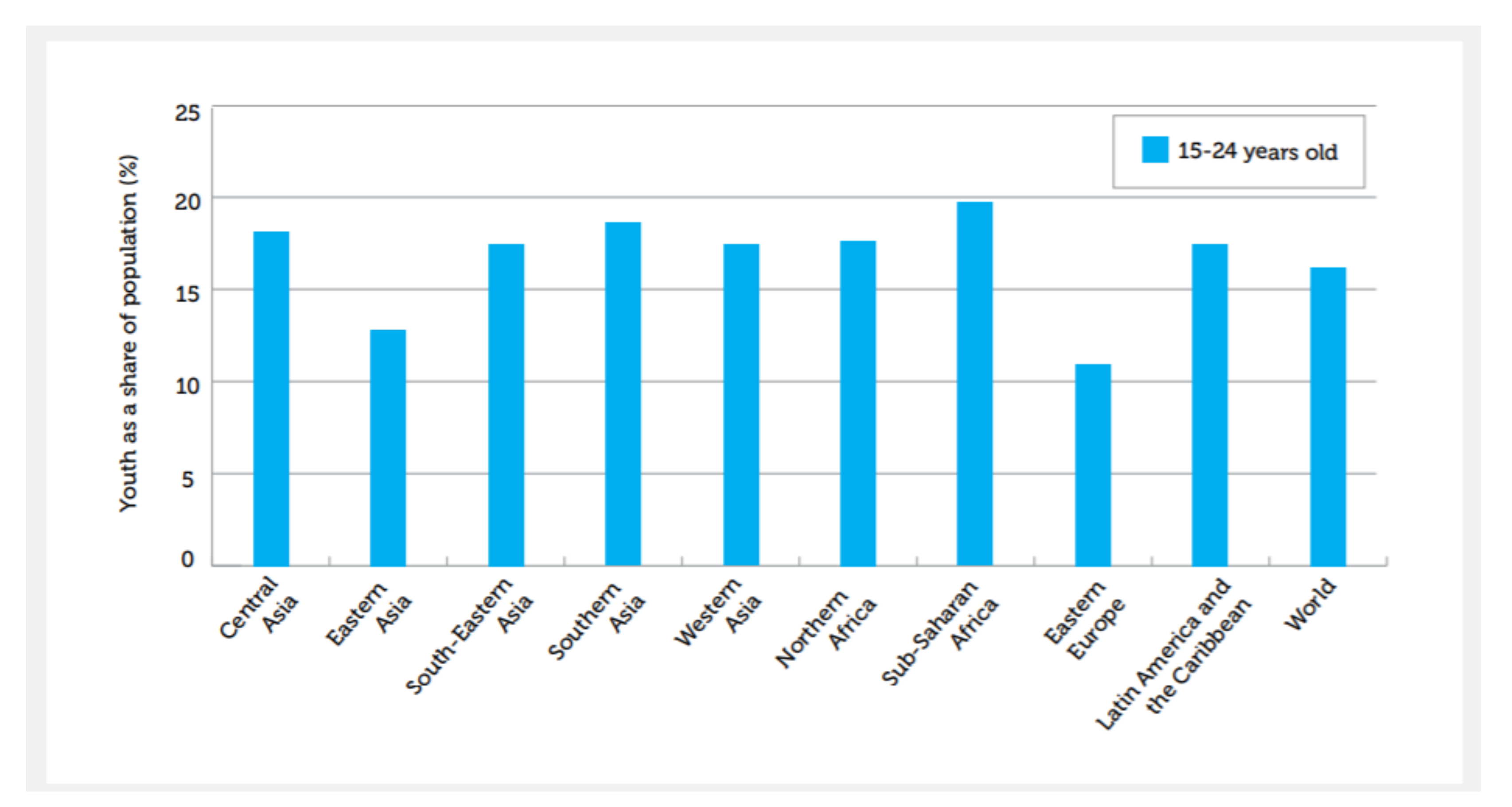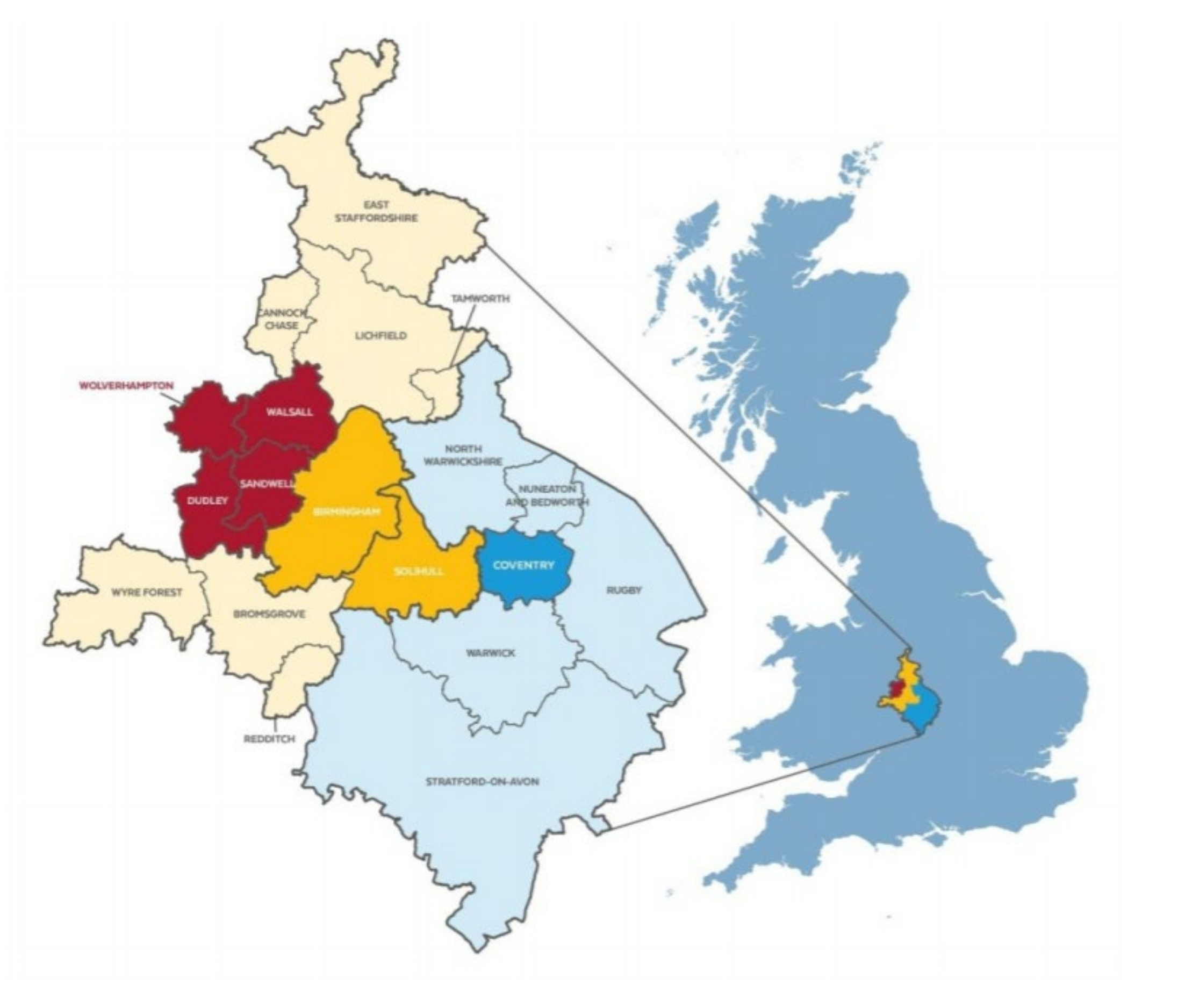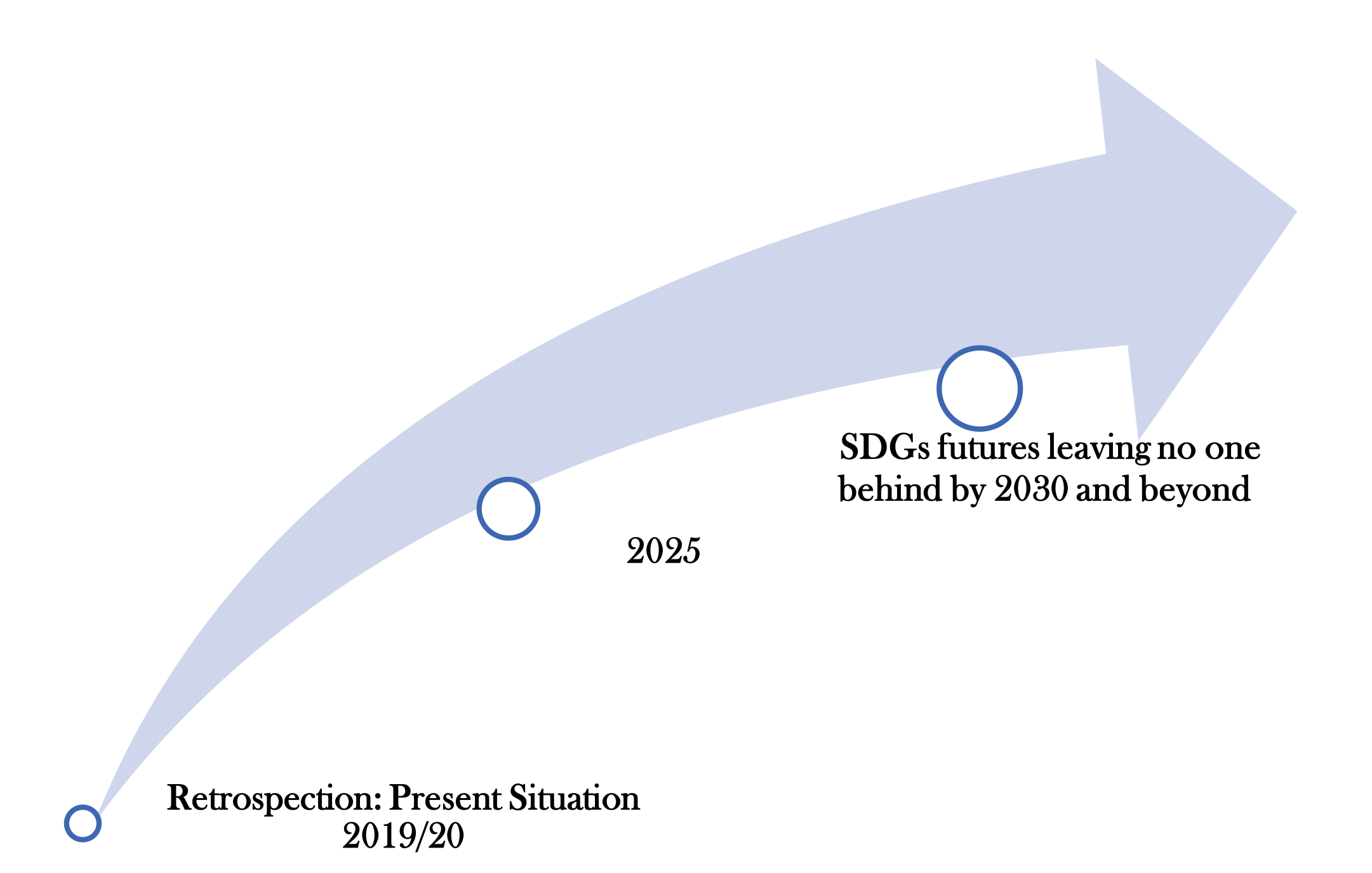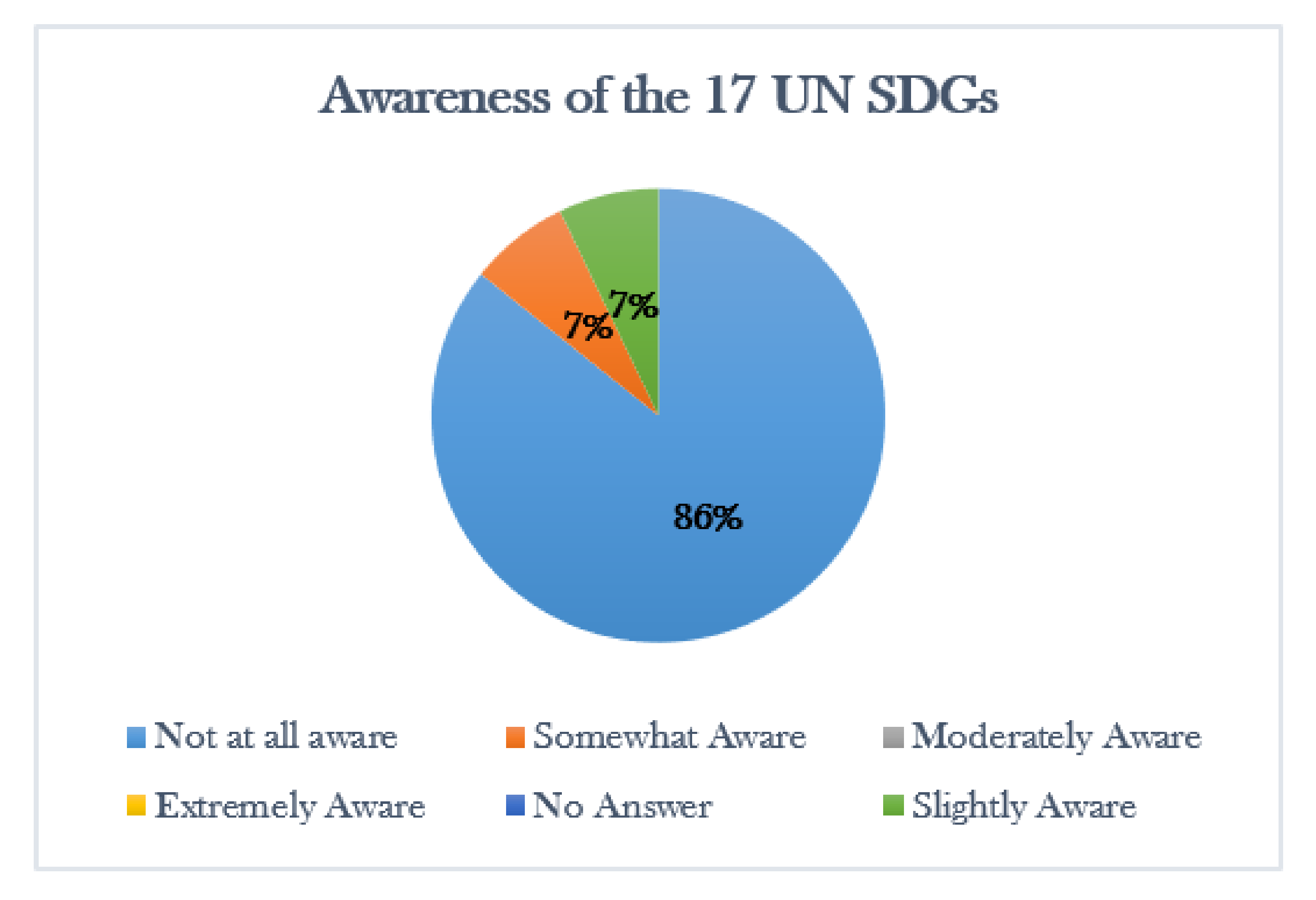Beyond Agenda 2030: Future-Oriented Mechanisms in Localising the Sustainable Development Goals (SDGs)
Abstract
1. Introduction
2. Context of the Study, Materials and Methods
2.1. Theoretical Framework
2.2. Why Focus on Youth—The Case
2.3. Case Study and Why the West Midlands Combined Authority Area
- Reducing health inequalities and improving the health and well-being of the population, including tackling mental health issues, air quality and the global climate crisis
- Improving life chances for all, including those facing particular disadvantages or difficulties
- Building a movement for inclusive leadership/inclusivity, prosperity and fairness by spreading the message of why diversity and inclusion matters via the Inclusive Leadership Pledge. This pledge is designed for employers, asking organisations and senior leaders to commit to promoting diversity and embedding inclusion. (This was reflected in the Leadership Commission’s call to realise a leadership that better represents the diversity of the West Midlands)
- Building the right skills in delivering improved productivity and prosperity, enabling all groups to access jobs. Improving skill levels so that people have the skills and qualifications to access jobs
- Improving place, infrastructure, air quality and the environment through addressing climate change
- As a result of these efforts, the WMCA has come to be recognised nationally in the annual league tables as one of the top performers on local sustainability initiatives [42].
2.4. SDGs Scenario Thinking Workshop Design: What Does ‘Leaving No One Behind’ Mean?
2.4.1. Stage 1: Stakeholder Selection in Localising the SDGs
2.4.2. Stage 2: SDGs Awareness and Knowledge Transfer
- Reduced Inequalities within Societies (SDG 10), i.e., businesses and authorities addressing societal and inequality issues, e.g., racism, gender pay gap, equal opportunities, discrimination in all forms etc.
- Climate Actions, Good-Health & Well-Being—(SDG 3 and SDG 13), i.e., deciding the type of air we breathe and combating climate change and its impacts
- Sustainable Production & Consumption Patterns (SDG 12), i.e., encouraging responsible consumption, reducing the environmental impacts of production, and developing more sustainable systems of production and consumption.
2.4.3. Stage 3: SDGs Collective-Vision-Based Scenario Thinking
2.4.4. Stage 4: SDGs Scenario Axis and Themes—What Are the Possible Futures?
2.4.5. Stage 5: SDGs Scenario Narratives & Drivers of Change
- Allocating one individual to write the scenarios quadrant stories.
- Ensuring everyone in the group participated in developing the SDGs stories, reflecting on their own experience, local knowledge and contemporary science.
- At the core of a foresight exercise, participants highlighting possible futures believed to be plausible and relevant for today’s decisions.
- What should the future look like in ten years? (focussing on both national and local level analyses)
- As a future leader in an organisation, what should be the local goal(s) around the SDGs, and how should it be achieved over the next ten years? (vision focus)
- What risks and challenges do we face over the next five to ten years? What contingency plans should we put in place? (risk management focus)
- What strategies are required to achieve the desired outcome? (strategy development focus)
2.4.6. Step 6: Scenarios Evaluation
2.4.7. Step 7: Post-Workshop Survey
3. Results
3.1. Pre-Workshop Survey on SDGs Awareness
3.2. Future Images
3.2.1. Transitioning to a Sustainable Low-Carbon Economy
3.2.2. Equitable and Just Society
3.2.3. Sustainable Consumption and Production Patterns
3.3. Post-Workshop Survey on SDGs Awareness
4. Discussion
4.1. Challenges & Opportunities
- All energy sources to be clean and energy should come from renewable sources
- Investment in technology, research and financial support for all countries, e.g., in adopting low-carbon technologies including sustainable production and transportation measures
- Promoting equitable society at all levels and encouraging multi-stakeholder partnerships to share knowledge and expertise in influencing the 2030 Agenda.
4.2. Assessment of the Theoretical Approach
5. Conclusions and Future Directions
- i
- Future-oriented systemic thinking: a holistic view of the SDGs and its approach to local development, i.e., building the know-how and capacity of local actors including civil societies to explore and understand SDGs complex/wicked problems nature. This measure will be useful in identifying and design plausible future scenarios, long-term planning and solutions and understand the systemic linkages inherent in SDG actions across sectors and scales.
- ii
- Inclusivity & Good Governance: encouraging and enabling multi-stakeholder decision-making, i.e., genuinely engage (formally or informally) with local community groups, minority groups, civil societies, academics, businesses, and financial organisations to jointly develop bespoke local SDGs bottom-up plans, policies, and programmes to—among other things—delineate and set local SD priorities and baselines.
- iii
- Community Resilience & Sustainability: new regulatory standards and policy incentives to strengthen institutional and fiscal/financial frameworks localising the SDGs, e.g., local government access to international and national public finance and public-private partnerships to implement SDGs mandates. Such investments and collaboration should support: job creation, SDGs knowledge and understanding, economic diversification, ecosystem integrity, intra and intergenerational equity and work towards building community resilience to withstand future shocks, such as the impact of climate change and pandemics, in pursuit of sustainable and thriving communities.
Author Contributions
Funding
Acknowledgments
Conflicts of Interest
Appendix A
| Not at all Aware | Slightly Aware | Somewhat Aware | Moderately Aware | Extremely Aware | No Answer |
| Strongly Agree | Agree | Neither Agree nor Disagree | Disagree | Strongly Disagree | No Answer |
| Strongly Agree | Agree | Neither Agree nor Disagree | Disagree | Strongly Disagree | No Answer |
| Strongly Agree | Agree | Neither Agree nor Disagree | Disagree | Strongly Disagree | No Answer |
| Excellent | Very Good | Good | Fair | Poor | No Answer |
| Not at all Useful | Slightly Useful | Moderately Useful | Very Useful | Extremely Useful | No Answer |
| Not at all Useful | Slightly Useful | Moderately Useful | Very Useful | Extremely Useful | No Answer |
| Not at all Useful | Slightly Useful | Moderately Useful | Very Useful | Extremely Useful | No Answer |
| Not at all Relevant | Slightly Relevant | Moderately Relevant | Very Relevant | Extremely Relevant | No Answer |
| Not at all Aware | Slightly Aware | Somewhat Aware | Moderately Aware | Extremely Aware | No Answer |
| Strongly Agree | Agree | Neither Agree nor Disagree | Disagree | Strongly Disagree | No Answer |
| Strongly Agree | Agree | Neither Agree nor Disagree | Disagree | Strongly Disagree | No Answer |
| Strongly Agree | Agree | Neither Agree nor Disagree | Disagree | Strongly Disagree | No Answer |
| Strongly Agree | Agree | Neither Agree nor Disagree | Disagree | Strongly Disagree | No Answer |
| Strongly Agree | Agree | Neither Agree nor Disagree | Disagree | Strongly Disagree | No Answer |
References
- Wiesmann, U.; Dayer, O. Research for Sustainable Development Goals: Introduction. GAIA Ecol. Perspect. Sci. Soc. 2019, 28, 88–89. [Google Scholar] [CrossRef]
- Meadowcroft, J. Who is in charge here? Governance for sustainable development in a complex world. J. Environ. 2007, 9, 299–314. [Google Scholar] [CrossRef]
- UCLG. United Cities and Local Governments’ Report to the 2020 HLPF 4th Report. Towards the Localization of the SDGs. How to Accelerate Transformative Actions in the Aftermath of the COVID-19 Outbreak. 2020. Available online: https://www.uclg.org/sites/default/files/report_localization_hlpf_2020.pdf (accessed on 23 October 2020).
- Weymouth, R.; Hartz-Karp, J. Principles for integrating the implementation of the sustainable development goals in cities. Urban Sci. 2018, 2, 77. [Google Scholar] [CrossRef]
- Global Taskforce of Local and Regional Governments. Roadmap for Localizing the SDGs: Implementation and Monitoring at Subnational Level. Global Taskforce of Local and Regional Governments, 2016. Available online: https://www.local2030.org/discover-tools (accessed on 25 August 2020).
- House of Commons. UK Implementation of the Sustainable Development Goals. House of Commons International Development Committee. First Report of Session 2016–2017. Available online: https://publications.parliament.uk/pa/cm201617/cmselect/cmintdev/103/103.pdf (accessed on 25 September 2020).
- Oosterhof, P.D. Localizing the Sustainable Development Goals to Accelerate Implementation of the 2030 Agenda for Sustainable Development. 2018. Available online: https://www.adb.org/sites/default/files/publication/472021/governance-brief-033-sdgs-implementation-2030-agenda.pdf (accessed on 18 November 2020).
- Partnerships Resource Centre. Wicked Problems Plaza: Principles and Practices for Effective Multi-Stakeholder Dialogue; Erasmus University: Rotterdam, The Netherlands, 2016. [Google Scholar]
- The United Nations Department of Economic and Social Affairs (UN DESA). Youth and the 2030 Agenda for Sustainable Development. 2018. Available online: https://www.un.org/development/desa/youth/world-youth-report/wyr2018.html (accessed on 25 August 2020).
- United Nations. Youth and the 2030 Agenda for Sustainable Development; UN: New York, NY, USA, 2018. [Google Scholar]
- HLPF. High-Level Political Forum on Sustainable Development. 2018. Available online: https://sustainabledevelopment.un.org/hlpf (accessed on 10 August 2020).
- MacDonald, A.; Clarke, A.; Huang, L.; Roseland, M.; Seitanidi, M.M. Multi-stakeholder partnerships (SDG# 17) as a means of achieving sustainable communities and cities (SDG# 11). In Handbook of Sustainability Science and Research; Springer: Cham, Switzerland, 2018; pp. 193–209. [Google Scholar]
- Bansard, J.S.; Hickmann, T.; Kern, K. Pathways to urban sustainability: How science can contribute to sustainable development in cities. GAIA Ecol. Perspect. Sci. Soc. 2019, 28, 112–118. [Google Scholar] [CrossRef]
- Clarke, A.; Macdonald, A. Outcomes to Partners in Multi-Stakeholder Cross-Sector Partnerships: A Resource-Based View. Bus. Soc. 2019, 58, 298–332. [Google Scholar] [CrossRef]
- Lukesch, R.; Ludvig, A.; Slee, B.; Weiss, G.; Živojinović, I. Social Innovation, Societal Change, and the Role of Policies. Sustainability 2020, 12, 7407. [Google Scholar] [CrossRef]
- Cederquist, A.; Golüke, U. Teaching with scenarios: A social innovation to foster learning and social change in times of great uncertainty. Eur. J. Futures Res. 2016, 4, 17. [Google Scholar] [CrossRef][Green Version]
- Millard, J. How social innovation underpins sustainable development. In Atlas of Social Innovation: New Practices for a Better Future; Howaldt, J., Kaletka, C., Schröder, A., Zirngiebl, M., Eds.; TU Dortmund University: Dortmund, Germany, 2018; pp. 41–43. [Google Scholar]
- Kahane, A. Transformative Scenario Planning: Working Together to Change the Future; Berrett-Koehler Publishers: San Francisco, CA, USA, 2012. [Google Scholar]
- Van Notten, P.W.; Sleegers, A.M.; van Asselt, M.B. The future shocks: On discontinuity and scenario development. Technol. Forecast. Soc. Chang. 2005, 72, 175–194. [Google Scholar] [CrossRef]
- Mäkelä, M.; Parkkinen, M.; Lyytimäki, J.; Nygrén, N.A. Futures images of woodchips as an energy source in Finland. Futures 2020, 121, 102571. [Google Scholar] [CrossRef]
- Eichler, G.; Schwarz, E.J. What Sustainable Development Goals Do Social Innovations Address? A Systematic Review and Content Analysis of Social Innovation Literature. Sustainability 2019, 11, 522. [Google Scholar] [CrossRef]
- Currie, W.L.; Seddon, J.J.M. Social Innovation in Public Health: Can Mobile Technology Make a Difference? Inf. Syst. Manag. 2014, 31, 187–199. [Google Scholar] [CrossRef]
- Hiteva, R.; Sovacool, B. Harnessing social innovation for energy justice: A business model perspective. Energy Policy. 2017, 107, 631–639. [Google Scholar] [CrossRef]
- Pultrone, G. Urban regeneration as an opportunity of social innovation and creative planning in urban peripheries. TECHNE J. Technol. Archit. Environ. 2017, 14, 139–146. [Google Scholar]
- Cruz, H.; Martínez, M.R.; Blanco, I. Crisis, urban segregation and social innovation in Catalonia. Partecip. Confl. 2017, 10, 221–245. [Google Scholar]
- Rover, O.J.; De Gennaro, B.C.; Roselli, L. Social Innovation and Sustainable Rural Development: The Case of a Brazilian Agroecology Network. Sustainability. 2016, 9, 3. [Google Scholar] [CrossRef]
- Moulaert, F.; MacCallum, D.; Hillier, J. Social innovation: Intuition, precept, concept, theory and practice. In The International Handbook on Social Innovation: Collective Action; Moulaert, F., MacCallum, D., Mehmood, A., Eds.; Social Learning and Transdisciplinary Research: Cheltenham, UK, 2013. [Google Scholar]
- Kluvankova, T.; Gežik, V.; Špaček, M.; Brnkaláková, S.; Slee, B.; Polman, N.; Valero, D.; Bryce, R.; Alkhaled, S.; Secco, L.; et al. Transdisciplinary Understanding of SI in MRAs. Report D2.2. Social Innovation in Marginalised Rural Areas Project (SIMRA), 2017. Available online: http://www.simra-h2020.eu/index.php/deliverables/ (accessed on 7 September 2020).
- Vergragt, P.J.; Quist, J. Backcasting for sustainability: Introduction to the special issue. Technol. Forecast. Soc. Chang. 2011, 78, 747–755. [Google Scholar] [CrossRef]
- Rialland, A.; Wold, K.E. Future Studies, Foresight and Scenarios as Basis for Better Strategic Decisions. Trondheim, December 2009. Available online: https://www.researchgate.net/profile/Agathe_Rialland/publication/268199766_Future_Studies_Foresight_and_Scenarios_as_basis_for_better_strategic_decisions/links/597f39230f7e9b8802ebafa3/Future-Studies-Foresight-and-Scenarios-as-basis-for-better-strategic-decisions.pdf (accessed on 18 November 2020).
- Bonsu, N.O.; Dhubháin, Á.N.; O’Connor, D. Evaluating the use of an integrated forest land-use planning approach in addressing forest ecosystem services conflicting demands: Experience within an Irish forest landscape. Futures 2017, 86, 1–17. [Google Scholar] [CrossRef]
- Biggs, R.; Raudsepp-Hearne, C.; Atkinson-Palombo, C.; Bohensky, E.; Boyd, E.; Cundill, G.; Fox, H.; Ingram, S.; Kok, K.; Spehar, S.; et al. Linking Futures across Scales: A Dialog on Multiscale Scenarios. Ecol. Soc. 2007, 12. [Google Scholar] [CrossRef]
- Kok, K.; Biggs, R.; Zurek, M. Methods for Developing Multiscale Participatory Scenarios: Insights from Southern Africa and Europe. Ecol. Soc. 2007, 12. [Google Scholar] [CrossRef]
- Henrichs, T.; Zurek, M.; Eickhout, B.; Kok, K.; Raudsepp-Hearne, C.; Ribeiro, T.; van Vuuren, D.; Volkery, A. Scenario development and analysis for forward-looking ecosystem assessments. In Ecosystems and Human Well-Being: A Manual for Assessment Practitioners; UN Environment World Conservation Monitoring Centre: Cambridge, UK, 2010; p. 151. [Google Scholar]
- van Vliet, M.; Kok, K. Combining backcasting and exploratory scenarios to develop robust water strategies in face of uncertain futures. Mitig. Adapt. Strat. Glob. Chang. 2013, 20, 43–74. [Google Scholar] [CrossRef]
- Oestreich, J.E. SDG 10: Reduce inequality in and among countries. Soc. Altern. 2018, 37, 34–41. [Google Scholar]
- Stake, R.E. Multiple Case Study Analysis; Guilford: New York, NY, USA, 2006. [Google Scholar]
- Yin, R.K. Case Study Research (Fifth edit); SAGE Publications: Los Angeles, CA, USA, 2014. [Google Scholar]
- Crowe, S.; Cresswell, K.; Robertson, A.; Huby, G.; Avery, A.; Sheikh, A. The case study approach. BMC Med Res. Methodol. 2011, 11, 100. [Google Scholar] [CrossRef] [PubMed]
- WMSR. In the West Midlands State of the Region 2019 Summary Report. 2019. Available online: https://www.wmca.org.uk/media/3267/state-of-the-region.pdf (accessed on 17 August 2020).
- West Midlands Combined Authority (WMCA). Youth-Inclusive Decision-Making Is about More than Being in the Room. 2019. Available online: https://www.wmca.org.uk/news/youth-inclusive-decision-making-is-about-more-than-being-in-the-room/ (accessed on 17 August 2020).
- WMCA. Actions to Meet the Climate Crisis with Inclusivity, Prosperity and Fairness. 2020. Available online: https://www.wmca.org.uk/media/4008/wm2041-final-003.pdf (accessed on 17 August 2020).
- SWM. Sustainability West Midlands Roadmap to 2030. 2020. Available online: https://www.sustainabilitywestmidlands.org.uk/roadmap-to-2030/ (accessed on 17 August 2020).
- Kuhmonen, T.; Kuhmonen, I. Rural futures in developed economies: The case of Finland. Technol. Forecast. Soc. Chang. 2015, 101, 366–374. [Google Scholar] [CrossRef]
- Kaboli, S.A.; Tapio, P. How late-modern nomads imagine tomorrow? A Causal Layered Analysis practice to explore the images of the future of young adults. Futures 2018, 96, 32–43. [Google Scholar] [CrossRef]
- Rowland, E.L.; Cross, M.S.; Hartmann, H. Considering Multiple Futures: Scenario Planning to Address Uncertainty in Natural Resource Conservation; US Fish and Wildlife Service: Washington, DC, USA, 2014. [Google Scholar]
- Noblet, C.L.; Anderson, M.W.; Teisl, M. Thinking past, thinking future: An empirical test of the effects of retrospective assessment on future preferences. Ecol. Econ. 2015, 114, 180–187. [Google Scholar] [CrossRef][Green Version]
- van’t Klooster, S.A.; van Asselt, M.B. Practising the scenario-axes technique. Futures 2006, 38, 15–30. [Google Scholar] [CrossRef]
- Wiseman, J.; Biggs, C.; Rickards, L.; Edwards, T. Scenarios for Climate Adaptation Guidebook for Practitioners; Victoria Centre for Climate Adaptation Research (VICCAR) University of Melbourne: Carlton, Australia, 2011. [Google Scholar]
- Kok, K.; Van Vliet, M.; Bärlund, I.; Dubel, A.; Sendzimir, J. Combining participative backcasting and exploratory scenario development: Experiences from the SCENES project. Technol. Forecast. Soc. Chang. 2011, 78, 835–851. [Google Scholar] [CrossRef]
- Bonsu, N.O. Towards a circular and low-carbon economy: Insights from the transitioning to electric vehicles and net-zero economy. J. Clean. Prod. 2020, 256, 120659. [Google Scholar] [CrossRef]
- United Nations Global Compact (UNGC). Uniting Business in the Decade of Action. Building on 20 Years of Progress. 2020. Available online: https://www.dnvgl.com/publications/UNGC-Report/download.html (accessed on 15 September 2020).
- Rittel, H.W.; Webber, M.M. Dilemmas in a general theory of planning. Policy Sci. 1973, 4, 155–169. [Google Scholar] [CrossRef]
- Trencher, G.; Yarime, M.; McCormick, K.B.; Doll, C.N.H.; Kraines, S.B. Beyond the third mission: Exploring the emerging university function of co-creation for sustainability. Sci. Public Policy. 2013, 41, 151–179. [Google Scholar] [CrossRef]
- SDGs Unit. Sustainable Development Goals Unit. In Towards Canada’s 2030 Agenda National Strategy; Employment and Social Development Canada: Ottawa, ON, Canada, 2019. [Google Scholar]
- Kruger, L.E.; Shannon, M.A. Getting to Know Ourselves and Our Places through Participation in Civic Social Assessment. Soc. Nat. Resour. 2000, 13, 461–478. [Google Scholar] [CrossRef]
- PwC. Turning Crisis into Opportunity. Annual Corporate Directors Survey. 2020. Available online: https://www.pwc.com/us/en/services/governance-insights-center/assets/pwc-2020-annual-corporate-directors-survey.pdf (accessed on 20 August 2020).
- Howaldt, J.; Kopp, R. Shaping Social Innovation by Social Research. In Challenge Social Innovation; Springer: Berlin/Heidelberg, Germany, 2012; pp. 43–55. [Google Scholar]
- Unceta, A.; Castro-Spila, J.; Fronti, J.G. Social innovation indicators. Innov. Eur. J. Soc. Sci. Res. 2016, 29, 192–204. [Google Scholar] [CrossRef]





| Future Images | Pathways | S | T | Econ | Env | P |
|---|---|---|---|---|---|---|
| Desirable, Positive Scenario by 2030 | • All energy will be renewable source by 2030 and beyond | ✔ | ||||
| • Low-carbon technologies as alternatives to fossil fuels, e.g., Electric Vehicles (EVs), Carbon Capture & Storage Systems etc. | ✔ | ✔ | ||||
| • Infrastructure Development, e.g., bikes lanes and EV charging etc. | ✔ | ✔ | ✔ | ✔ | ||
| • Investment in research and technology | ✔ | ✔ | ||||
| • Nationalise public transport | ✔ | |||||
| • Education and supporting developing countries | ✔ | ✔ | ||||
| Positive, Good Scenario by 2030 | • Adoption of renewables use | ✔ | ||||
| • More people becoming aware of the SDGs | ✔ | ✔ | ||||
| • National Health Service (NHS) involvement | ✔ | |||||
| • More vegetables and vegan/vegetarian people | ✔ | ✔ | ||||
| • Efficient spending on measures | ✔ |
| Future Images | Pathways | S | T | Econ | Env | P |
|---|---|---|---|---|---|---|
| Desirable, Positive Scenario by 2030 | • Equal access to good healthcare and good education, including cheaper access to cleaner transport | ✔ | ✔ | |||
| • Zero discrimination and diversity within businesses (both public and private entities) | ✔ | ✔ | ||||
| • Better and equitable access to technology/ICT, and guidance on using technology | ✔ | ✔ | ✔ | |||
| • Youth empowerment, including community and political involvement and representation at the top level, e.g., Member of Parliament | ✔ | ✔ | ||||
| • Tackling income inequality, gender pay gap and youth having role models amongst the different cultures in societies | ✔ | ✔ | ✔ | |||
| • Equal criminal justice system and tackling racism, homophobia etc. | ✔ | |||||
| • Cheaper and accessible transport system | ✔ | ✔ | ||||
| • Zero pollution, green transport and recycling | ✔ | |||||
| Positive, Good Scenario by 2030 | • Equal punishment for all gender across race and criminal justice system | ✔ | ✔ | |||
| • Improved quality of the transport system | ✔ | |||||
| • Improved knowledge access to technology and communication | ✔ | |||||
| • Increase in diversity and income inequality, including racial representation in the workplace, schools etc. | ✔ | |||||
| • Opportunities for apprenticeship | ✔ | ✔ | ||||
| • Climate change education and environmental pollution awareness creation | ✔ | ✔ | ||||
| • Strict environmental rules and incentivising pro-environmental behaviours/attitudes | ✔ | ✔ |
| Future Images | Pathways | S | T | Econ | Env | P |
|---|---|---|---|---|---|---|
| Desirable, Positive Scenario by 2030 | • All energy from renewable sources | ✔ | ||||
| • Efficient production methods and systems | ✔ | |||||
| • Waste reduction and circular economy business models, including plastics | ✔ | ✔ | ✔ | |||
| • Reduced consumers consumption patterns, i.e., tackling food waste and water scarcity | ✔ | ✔ | ||||
| • Charity tax and rooting out corruption | ✔ | ✔ | ||||
| • International support for Low-Middle Income Countries (LMICs) | ✔ | ✔ | ||||
| Positive, Good Scenario by 2030 | • Enforcing and incentivising efficient production and consumption patterns, i.e., tackling food waste and water scarcity | ✔ | ✔ | ✔ | ||
| • Incentivising (rewarding) renewable energy use/sources | ✔ | ✔ | ✔ | |||
| • Addressing corruption at all levels and helping LMICs to prioritise sustainable production and consumption patterns, the introduction of charity tax | ✔ | ✔ | ||||
| • Volunteering and efforts to transition to sustainable consumption and production | ✔ | ✔ |
Publisher’s Note: MDPI stays neutral with regard to jurisdictional claims in published maps and institutional affiliations. |
© 2020 by the authors. Licensee MDPI, Basel, Switzerland. This article is an open access article distributed under the terms and conditions of the Creative Commons Attribution (CC BY) license (http://creativecommons.org/licenses/by/4.0/).
Share and Cite
Bonsu, N.O.; TyreeHageman, J.; Kele, J. Beyond Agenda 2030: Future-Oriented Mechanisms in Localising the Sustainable Development Goals (SDGs). Sustainability 2020, 12, 9797. https://doi.org/10.3390/su12239797
Bonsu NO, TyreeHageman J, Kele J. Beyond Agenda 2030: Future-Oriented Mechanisms in Localising the Sustainable Development Goals (SDGs). Sustainability. 2020; 12(23):9797. https://doi.org/10.3390/su12239797
Chicago/Turabian StyleBonsu, Nana Osei, Jennifer TyreeHageman, and Juliet Kele. 2020. "Beyond Agenda 2030: Future-Oriented Mechanisms in Localising the Sustainable Development Goals (SDGs)" Sustainability 12, no. 23: 9797. https://doi.org/10.3390/su12239797
APA StyleBonsu, N. O., TyreeHageman, J., & Kele, J. (2020). Beyond Agenda 2030: Future-Oriented Mechanisms in Localising the Sustainable Development Goals (SDGs). Sustainability, 12(23), 9797. https://doi.org/10.3390/su12239797





